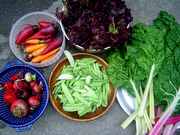

|
| Vegetable Varieties for Gardeners is a citizen science program
|
|
|
|
'Lutz Green Leaf' Beets |
| |
| Sub-Category: |
Round Red
|
| |
|
| Sub-Category 2: |
| | Description: |
Slow grower producing 4- to 6-inch, slightly elongated globe-shaped roots and dark-green, chard-like leaves with no purple. Stores well. Also known as 'Lutz', 'Lutz Winter Keeper' and 'Lutz Salad Leaf'.
|
| Days To Maturity: |
60-80
|
| Seed Sources: |
|
| |
| Rating Summary |
| |
Overall: (4.7 Stars)
Taste: (4.5 Stars)
Yield: (4.8 Stars)
Ease/Reliability: (4.7 Stars) |
| |
| Reviews |
| |
Login to share your Review of Lutz Green Leaf.
Number of Reviews: 6
KEY: O=Overall Rating, T=Taste, Y=Yield, E=Ease
Reviewed on 01/12/2017 by
Peggy\'s patch
- An intermediate gardener
|
 Overall Overall
 Taste Taste
 Yield Yield
 Ease Ease
|
Crawford, Pennsylvania, United States
Frost Free Season: 103 - 123 days
Soil Texture: Clay
Garden Size: Large - More than 1,600 square feet (40' x 40')
Sun Exposure: More than 8 hours per day
|
| Keeps in our root cellar all winter. Huge, \r\nSweet and delicious! |
| |
|
Reviewed on 03/06/2008 by
Gombasz
- An experienced gardener
|
 Overall Overall
 Taste Taste
 Yield Yield
 Ease Ease
|
Somerset, New Jersey, United States
Frost Free Season: 183 - 203 days
Soil Texture: Loam
Garden Size: Small - Less than 400 square feet (20' x 20')
Sun Exposure: More than 8 hours per day
|
| A wonderful beet for storage. I always get heavy yields of large rather ugly looking roots, but they keep splendidly in damp sand in a basement or other cool location. As others have pointed out the roots stay tender and flavorful and never get woody no matter the size. Their growing season is long so a Spring planting can be harvested in September or later. Excellent baked. |
| | | 1 of 1 gardener found this review helpful.
|
|
Reviewed on 11/20/2006 by
Nancy Strasser
- An experienced gardener
|
 Overall Overall
 Taste Taste
 Yield Yield
 Ease Ease
|
Pulaski, Virginia, United States
Frost Free Season: 143 - 163 days
Soil Texture: Clay
Garden Size: Large - More than 1,600 square feet (40' x 40')
Sun Exposure: More than 8 hours per day
|
| Very tasty beet. The greens were very tasty, but not as attractive as some other beets. Early and mid-season beets produced well. I planted a late crop to check out the winter-keeper properties; but I haven't yet harvested any. Time (and cold weather) will tell. |
| | | 1 of 1 gardener found this review helpful.
|
|
Reviewed on 09/28/2005 by
Lisa in Oregon
- An intermediate gardener
|
 Overall Overall
 Taste Taste
 Yield Yield
 Ease Ease
|
Oregon, United States
Frost Free Season: 163 - 183 days
Soil Texture: Clay
Garden Size: Large - More than 1,600 square feet (40' x 40')
Sun Exposure: More than 8 hours per day
|
| Does indeed overwinter very well and nice big roots don't get woody. The beet flavor and color is not as strong and distinctive as other beets - easier to clean up, but the borscht lacked some flavor. |
| | | 1 of 1 gardener found this review helpful.
|
|
Reviewed on 11/01/2004 by
Daisy's Mom
- An experienced gardener
|
 Overall Overall
 Taste Taste
 Yield Yield
 Ease Ease
|
Monroe, New York, United States
Frost Free Season: 163 - 183 days
Soil Texture: Clay
Garden Size: Medium - 400 square feet to 1,600 square feet
Sun Exposure: More than 8 hours per day
|
| Enormous is the best word to describe the leaves and the roots! Tender roots even when large. |
| | | 1 of 1 gardener found this review helpful.
|
|
Reviewed on 09/16/2004 by
George Morrison
- An experienced gardener
|
 Overall Overall
 Taste Taste
 Yield Yield
 Ease Ease
|
Westchester, New York, United States
Frost Free Season: 163 - 183 days
Soil Texture: Clay
Garden Size: Medium - 400 square feet to 1,600 square feet
Sun Exposure: Less than 6 hours per day
|
| If you only have room for one beet variety, Lutz Green Leaf or Winter Keeper would make a good choice. Unlike most beets, this variety is grown for its leaves as well as its roots. Even better, the roots, no matter how large they get, never become woody. They may not be the prettiest beets in the neighborhood but they are the sweetest and tenderest. You can pick them as late as the fall from a spring sowing. |
| | | 1 of 1 gardener found this review helpful.
|
|
|
|
|
Vegetable Varieties for Gardeners is a citizen science program, © 2004-2024, All Rights Reserved
Cornell Garden Based Learning, Cornell University College of Agriculture & Life Sciences, Horticulture Section
|






 VVfG home
VVfG home
 Overall
Overall Yield
Yield Taste
Taste